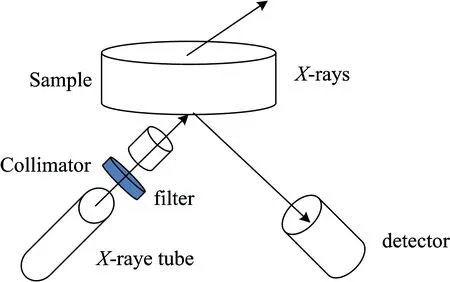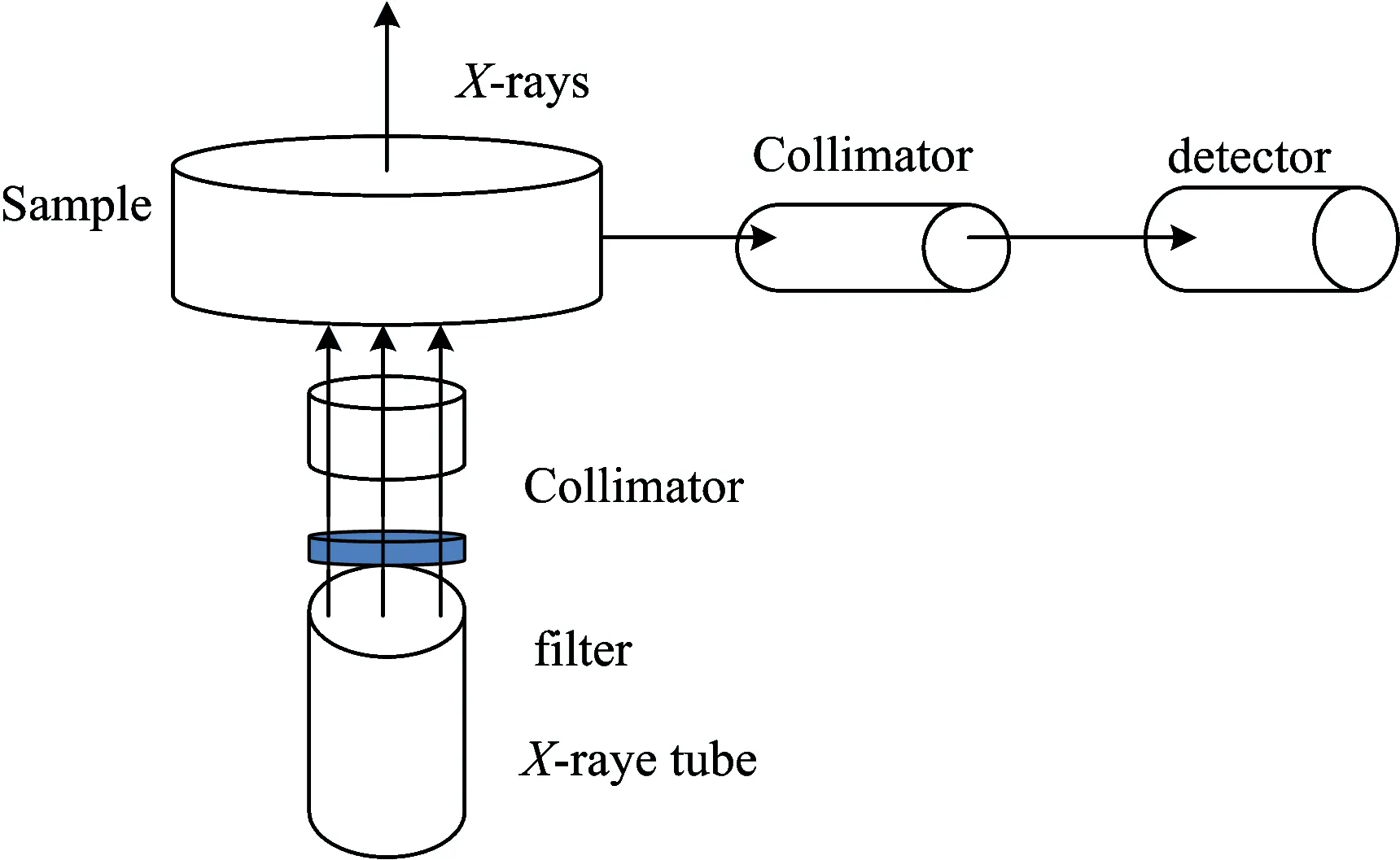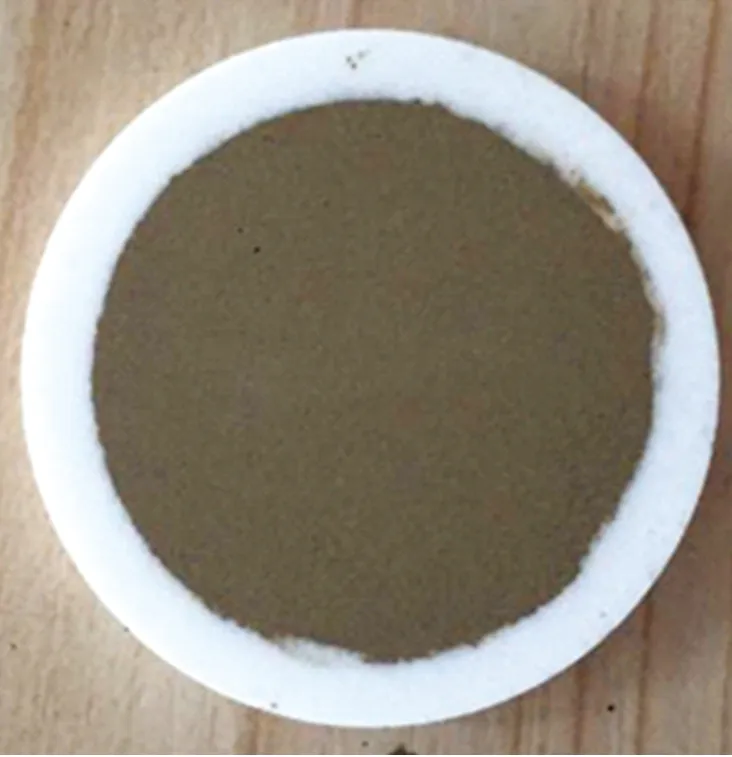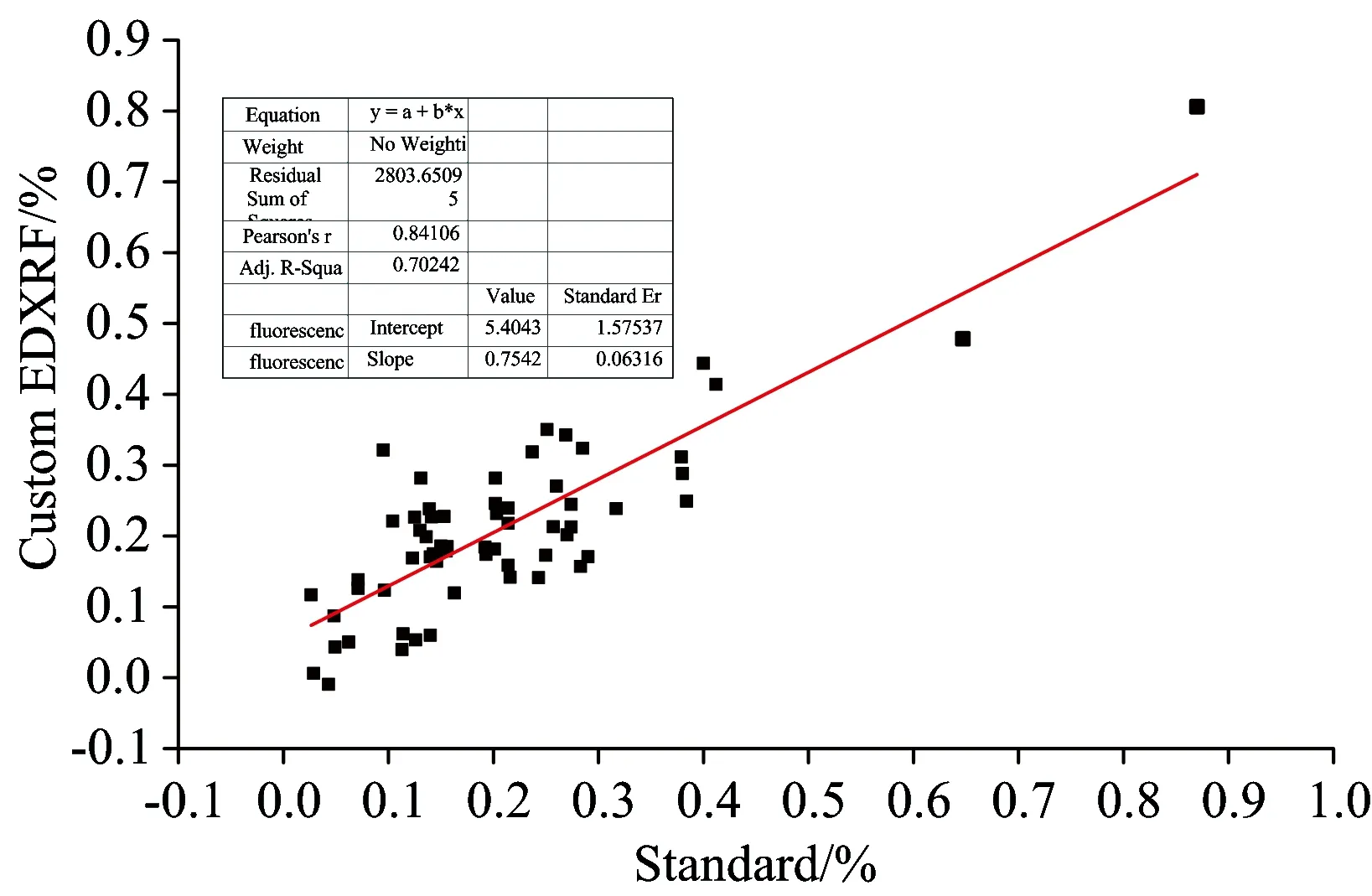Study on Heavy Metal Detection in Soil with Improved EDXRF
2016-07-12YUJieHONGXuMAYingjieZHOUJianbinWANGYiqiangWANGMinLUYuansheng
YU Jie, HONG Xu, MA Ying-jie*, ZHOU Jian-bin,WANG Yi-qiang, WANG Min, LU Yuan-sheng
1. Chengdu University of Technology, Chengdu 610059, China
2. Jilin University, Changchun 130012, China
Study on Heavy Metal Detection in Soil with Improved EDXRF
YU Jie1, HONG Xu1, MA Ying-jie1*, ZHOU Jian-bin1,WANG Yi-qiang2, WANG Min1, LU Yuan-sheng1
1. Chengdu University of Technology, Chengdu 610059, China
2. Jilin University, Changchun 130012, China
Due to the low precision and accuracy of trace heavy metals detection wiith traditional energy dispersive X-ray fluorescence (EDXRF) system, an improved EDXRF system is proposed. In order to reduce the influence of reflected rays, the sample is irradiated with the incident X-rays vertically, and the detector is placed in parallel with the sample’s section. The sample is connected with detector through collimator. With improved EDXRF measures certified reference materials, the results show that the detection limit of the improved EDXRF system for Mo,Zn,Cu,Pb,Zr,Nb is 0.4,6.68,1.97,6.84,1.60,7.59 mg·kg-1respectively and the logarithm deviation of each element in the standard samples is between 0 and 0.05. The RSD%(GBW) is less than 7 as the element content is more than three times of the detection limit, and it is below 15 when the element content is less than three times of the detection limit. The soil samples collected from Da Xing’an Ling region are applied to verify the improved EDXRF system. The proposed EDXRF system can improve the measurement accuracy of trace heavy metal detection in soil, satisfying the requirements of geologic exploration.
EDXRF; soil; Heavy metal detection; Measurement accuracy
Introduction
The methods of heavy metal detection in soil include chemical analysis method, spectroscopic analysis method, electrochemical analysis method, chromatography, atomic absorption analysis method and chemiluminescence[1]. Though these methods have the advantages of high accuracy, good precision, they need complex long time process, at high cost with the risks of sample contamination. With the advantages of rapid measurement, low cost and nondestructive detecting, EDXRF is widely used in metallurgy, geology, nonferrous metals, building materials, commodity inspection, environmental protection and other fields. A portable XRF method was used to analyze heavy metals in soil by Han Ping[2]. Zhang Rong et al[3]to detect Pb in soil by using portable XRF. Also, EDXRF was applied for quantitative analysis in nickel laterite ore[4]. DU Guo-dong et al[5]measured Ni in soil using the portable X-ray fluorescence spectrometer. WANG Bao et al[6]used the portable X-ray fluorescence spectrometer for rapid detection of heavy metals in soil environmental quality. GONG Chun-hui et al[7]used WDXRF to measure trace elements in tea. Based on the investigation in Da Xing’an Ling, the improved EDXRF is equipped to analyze the samples which are collected in 10 centimeters underground, providing accurate data for ore-forming determination and environmental monitoring.
1 Improved EDXRF Syetem
The conventional EDXRF system is shown in Fig.1. It can be seen that the incident X-rays irradiates the sample at a certain angle and the detector detects the characteristic X-ray at the other side. The incident X-rays could penetrate the sample because the heavy metal level in the sample is low. Besides, the X-rays reflected from the surface of the sample can increase the background while the detector and sample forming a certain angle. Thus, the conventional EDXRF system has poor measurement stability in trace of heavy metal elements in soil.Fig.2 illustrates the improved EDXRF system. In this system, the sample is exposed vertically to the incident X-rays. The detector is placed in parallel with the sample’s sction reducing the reflected X-rays. In order to improve detection efficiency, the collimator is used to connect the sample with the detector.

Fig.1 Custom EDXRF system

Fig.2 Improved EDXRF system
2 Experimental preparation
2.1 Sample preparation
Significant errors of EDXRF may be generated due to the properties of the sample, which includes particle size, mineral composition and matrix effect. In order to reduce the errors, soil sample is selected as standard sample and the standard sample should have a wide range of content and suitable content-grads[8].
Using boric acid as the edge of the sample means it is easier than using plastic ring or hoop as the edge, and it is also free of contamination. Since the EDXRF performance will be affected by soil moisture and particle size, the soil is dried in the dryer for 24 hours first, and then it is grinded to 200 meshes by using automatic grinding machine. Finally, the soil is put into bags with serial numbers. Agateware is used in the process of preprocessing to avoid contamination. The sample is prepared under the pressure of 20 MPa weights 5 grams and the inside and outside diameters of the sample are 32 and 36 mm respectively, as shown in Fig.3. The mold is cleaned with cotton dipping in alcohol before preparing sample to avoid cross-contamination. The prepared sample should be measured immediately or placed in cool place to prevent the surface of the sample deformation.

Fig.3 Prepared sample
2.2 Calibration of instrument
The calibration currency of instrument has an important effect on the final results. EDXRF is a relative method for heavy metal detection in soil, which means the standard sample should be measured before the prepared sample. Therefore the content measurement for the standard sample requires accuracy. Fig.4 is the contrast result between the standard value and the custom EDXRF system. It indicates that the linearity is about 0.70 while that of result for improved EDXRF system is up to 0.97 shown in Fig.5.

Fig.4 Contrast result between the standard and the conventional EDXRF system

Fig.5 Contrast result between the standard and the improved EDXRF system
3 Experimental test
3.1 Detection limit
The detection limit is obtained through unit of count rate, background count and measurement time of the standard samples[9]. The results shows that the detection limits of Mo,Zn,Cu,Pb,Zr,Nb are 0.4,6.68,1.97,6.84,1.60,7.59 mg·kg-1respectively.
3.2 Accuracy and precision


Table 1 Geochemical exploration requirements for accuracy and precision

Table 2 Results of accuracy and precision for GSS-2 and GSS-9
3.3 Sample measurement
The prepared soil samples are collected from three regions in Da Xing’an Ling namely Ht20, Ht1 and Ht10. In Ht20 region, 527 samples are collected. There are 822 samples being collected in Ht1 and 732 samples in Ht10. The measurement results of the target elements with different EDXRF systems are listed in table 3. As can be seen in table 3, the improved EDXRF system is more accurate than the traditional EDXRF system for heavy metal detection in soil, especially in trace metal elements detection. It has higher stability than that of traditional EDXRF as for higher content of heavy metal elements.

Table 3 Comparison of the measurement results
4 Conclusion
The improved EDXRF system has better accuracy and precision than traditional EDXRF system as to the application of tracing heavy metal elements detection. Multiple measurements of standard samples show that the improved EDXRF system can meet the requirements of geochemistry exploration. The measurement results in Da Xing’an ling region show that improved EDXRF has lower detection limit and it is more accurate in trace metal elements measurement. The system has the advantages of high measurement speed, accuracy performance and non-destructiveness; it can be used in geological exploration and environment monitoring.
[1] Ren Haixian, Wang Yingjin. Journal of Molecular Science,2009, 25(3): 213.
[2] Han Ping, Wang Jihua, Lu Anxiang, et al. Spectroscopy and Spectral Analysis, 2012, 32(3): 826.
[3] Zhang Rong, Zhang Yujun, Zhang Wei, et al. Spectroscopy and Spectral Analysis, 2013, 33(2): 554.
[4] Li Yan, Dong Xiuwen, Zhao Junfeng, et al. Journal of Analytical Science,2014, 30(2): 191.
[5] Du Guodong, Lei Mei, Zhou Guangdong, et al. Spectroscopy and Spectral Analysis, 2015, 35(3): 809.
[6] Wang Bao, Yu Jianxing, Huang Biao, et al. Spectroscopy and Spectral Analysis, 2015, 35(6): 1735.
[7] Gong Chunhui, Zeng Guoqiang, Ge Liangquan, et al. Nuclear Techniques, 2013, 36(9): 090201.
[8] Li Guohui, Ji Ang, Zhang Hua. Physical and Chemical Inspection-in Chemistry, 2005, 41: 5.
[9] Sun Pinhui. Spectroscopy and Spectral Analysis, 1994, 14(2): 121.
O657.3
A
改进X荧光光谱仪快速检测土壤中重金属
喻 杰1,洪 旭1,马英杰1*,周建斌1,王义强2,王 敏1,卢远盛1
1. 成都理工大学核技术与自动化工程学院,四川 成都 610059
2. 吉林大学,吉林 长春 130012
针对传统能量色散X荧光仪(energy dispersive X-ray fluorescence,EDXRF)分析土壤中微量重金属测量精确度低的问题,提出了一种X荧光仪改进方法。为了减少反射X射线的影响,入射X射线垂直照射样品,探测器平行放置与样品一侧且垂直于X射线。样品与探测器之间由准直器连接。对国家标样测量结果表明,仪器对Mo,Zn,Cu,Pb,Zr,Nb的检出限为0.4,6.68,1.97,6.84,1.60,7.59 mg·kg-1。各元素对数偏差在0~0.05之间。元素含量在三倍检出限以上RSD%(GBW)小于7,元素含量在三倍检出限内RSD%(GBW)小于15。为了验证改进后X荧光仪测量效果,在大兴安岭地区采集土壤样品与传统荧光仪进行比较分析。改进X荧光仪提高了土壤中微量重金属测量精度,满足野外地质普查要求。
能量色散X荧光仪;土壤;重金属;测量精度
2016-01-25,
2016-04-19)
10.3964/j.issn.1000-0593(2016)10-3429-05
Foundation item:Natural Science Foundation of China(11475036)
Received:2016-01-25; accepted:2016-04-19
Biography:YU Jie, (1989—), Postgraduate, in Chengdu University of Technology e-mail: 1046761862@qq.com *Corresponding author e-mail:hongxucdut@163.com
*通讯联系人
猜你喜欢
杂志排行
光谱学与光谱分析的其它文章
- Gd靶激光等离子体光源离带辐射及其等离子体演化的研究
- Probing the Binding of Torasemide to Pepsin and Trypsin by Spectroscopic and Molecular Docking Methods
- Mn(Ⅱ)-5-Br-PADAP共沉淀-火焰原子吸收光谱法测定虾、贝样中的镉
- Near Infrared Spectroscopy Study on Nitrogen in Shortcut Nitrification and Denitrification Using Principal Component Analysis Combined with BP Neural Networks
- 内蒙古草原植被最大光能利用率取值优化研究
- 健康和糖尿病大鼠红细胞荧光光谱非线性程度差异
